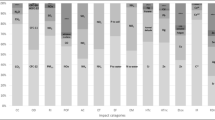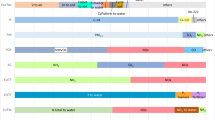Abstract
Purpose
When performing a life cycle assessment (LCA), the LCA practitioner faces the need to express the characterized results in a form suitable for the final interpretation. This can be done using normalization against some common reference impact—the normalization references—which require regular updates. The study presents updated sets of normalization inventories, normalization references for the EDIP97/EDIP2003 methodology and guidance on their consistent use in practice.
Materials and methods
The base year of the inventory is 2004; the geographical scope for the non-global impacts is limited to Europe. The emission inventory was collected from different publicly available databases and monitoring bodies. Where necessary, gaps were filled using extrapolations. A new approach for inventorizing specific groups of substances—non-methane volatile organic compounds and pesticides—was also developed. The resulting inventory was combined with the most updated sets of characterization factors for each impact category in the EDIP methodologies.
Results and discussion
Normalization references are provided for global and non-global impact categories for the year 2004, and causes of variations compared to previous versions are identified. For the non-toxic impact categories, they mainly reflect demographic evolution or change in emission intensities. For the toxic impact categories, they are strongly dependent on improvements in the characterization models as well as on the inventory analysis. Differentiation of substance groups into individual substance emissions is an important source, which leads to identification of inconsistencies in the current practice and guidance to ensure compatibility between LCI and LCIA. Uncertainties are not quantified but are mainly expected to lie in the toxic substance inventories, which are known not to encompass all potentially harmful chemicals released in Europe, e.g. omitting some toxic metals.
Conclusions
The present study provides the most updated set of publicly available normalization references for the EDIP methodology and emission inventories for Europe that may also serve for the calculation of normalization references for other impact categories. It is believed to be the best estimate available for Europe and is thus recommended for use along with the guidance provided in this study.

Similar content being viewed by others
References
Birkved M, Hauschild MZ (2006) PestLCI-a model for estimating field emissions of pesticides in agricultural LCA. Ecol Model 198(3–4):433–451
LCA Center (2010) Expected to provide updated characterization factors for the EDIP methodology. www.lca-center.dk Accessed Apr 2010
Dreyer LC, Niemann AL, Hauschild MZ (2003) Comparison of three different LCIA methods: EDIP97, CML2001 and Eco-indicator 99 – does it matter which one you choose? Int J Life Cycle Assess 8(4):191–200
Ecoinvent Centre (2007) Ecoinvent data. Swiss Centre for Life Cycle Inventories. Dübendorf. www.ecoinvent.ch
EUROSTAT (2010) Tables, section Environment and Energy–expected to contain yearly updated data (both national and European). http://epp.eurostat.ec.europa.eu/portal/page/portal/energy/data/main_tables Accessed Mar 2010
Finnveden G, Hauschild MZ, Ekvall T, Guinee J, Heijungs R, Hellweg S, Koehler A, Pennington D, Suh S (2009) Recent developments in life cycle assessment. J Environ Manage 91(1):1–21
Guinée JB, Gorrée M, Heijungs R, Huppes G, Kleijn R, Koning Ad, Oers Lv, Wegener Sleeswijk A, Suh S, de Haes HA Udo, Bruijn Hd, Duin Rv, Huijbregts MAJ (2002) Handbook on life cycle assessment. Operational guide to the ISO standards. I: LCA in perspective. IIa: Guide. IIb: Operational annex. III: Scientific background. Kluwer, Dordrecht, p 692
Hauschild M, Potting J (2005) Spatial differentiation in LCA impact assessment – the EDIP 2003 methodology. Environmental news No. 80 2005. Danish Environmental Protection Agency. Copenhagen, Denmark. http://www2.mst.dk/udgiv/publications/2005/87-7614-579-4/pdf/87-7614-580-8.pdf Accessed Mar 2010
Hauschild M, Wenzel H (1998) Environmental assessment of products. Volume 2 – scientific background. Chapman and Hall, Thomson Science, London, 0-412-80810-2
ISO (2006) ISO 14044 International Standard. In: Environmental management – life cycle assessment – requirements and guidelines. International Standard Organization, Geneva
Lautier A, Rosenbaum RK, Margni M, Bare J, Roy P, Deschênes L (2010) Development of normalization factors for Canada and the United States and comparison with European factors. Sci Total Environ 409(1):33–42
Nemecek T, Kägi T (2007) Life cycle inventories of Swiss and European agricultural production systems. Final report Ecoinvent V2.0 No. 15a. Agroscope Reckenholz-Taenikon Research Station ART, Swiss Centre for Life Cycle Inventories. Zurich and Dübendorf, Switzerland. www.ecoinvent.ch Accessed May 2010
Pant R, Van Hoof G, Schowanek D, Feijtel TCJ, de Koning A, Hauschild M, Pennington DW, Olsen SI, Rosenbaum R (2004) Comparison between three different LCIA methods for aquatic ecotoxicity and a product environmental risk assessment – insights from a detergent case study within OMNIITOX. Int J Life Cycle Assess 9(5):295–306
Potting J, Hauschild M (2005) Background for spatial differentiation in LCA impact assessment–the EDIP 2003 methodology. Environmental project no. 996 2005. Danish Environmental Protection Agency. Copenhagen, Denmark. http://www2.mst.dk/Udgiv/publications/2005/87-7614-581-6/pdf/87-7614-582-4.pdf Accessed Mar 2010
Sleeswijk AW, Huijbregts MAJ, van Oers LFCM, Guinée JB, Struijs J (2008) Normalisation in product life cycle assessment: an LCA of the global and European economic systems in the year 2000. Sci Total Environ 390(1):227–240
Stranddorf HK, Hoffmann L, Schmidt A (2005) Update on impact categories, normalisation and weighting in LCA–selected EDIP97 data. Environmental Project Nr. 995 2005. Danish Environmental Protection Agency, Copenhagen
UNSD (2010) Demographic Yearbooks (years 2004, 2005, 2006, 2007) – available on the UNSD website. http://unstats.un.org/unsd/demographic/products/dyb/2000_round.htm Accessed Mar 2010
Wenzel H, Hauschild M, Alting L (1997) Environmental assessment of products. Volume 1–methodology, tools and case studies in product development. Chapman and Hall, Thomson Science, London, 0-792-37859-8
Author information
Authors and Affiliations
Corresponding author
Additional information
Responsible editor: Berlan Rodríguez-Perez
Rights and permissions
About this article
Cite this article
Laurent, A., Olsen, S.I. & Hauschild, M.Z. Normalization in EDIP97 and EDIP2003: updated European inventory for 2004 and guidance towards a consistent use in practice. Int J Life Cycle Assess 16, 401–409 (2011). https://doi.org/10.1007/s11367-011-0278-6
Received:
Accepted:
Published:
Issue Date:
DOI: https://doi.org/10.1007/s11367-011-0278-6




